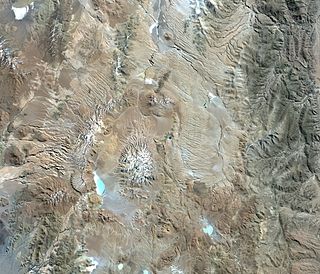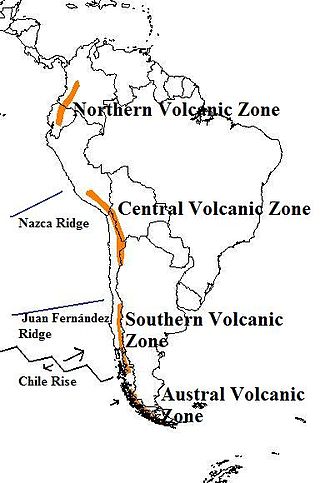Related Research Articles

Cerro Galán is a caldera in the Catamarca Province of Argentina. It is one of the largest exposed calderas in the world and forms part of the Central Volcanic Zone of the Andes, one of the three volcanic belts found in South America. One of several major caldera systems in the Central Volcanic Zone, the mountain is grouped into the Altiplano–Puna volcanic complex.

Nevado de Longaví is a volcano in the Andes of central Chile. The 3,242 m (10,636 ft) high volcano lies in the Linares Province, which is part of the Maule Region. It features a summit crater and several parasitic vents. The volcano is constructed principally from lava flows. Two collapses of the edifice have carved collapse scars into the volcano, one on the eastern slope known as Lomas Limpias and another on the southwestern slope known as Los Bueye. The volcano features a glacier and the Achibueno and Blanco rivers originate on the mountain.

The Andean Volcanic Belt is a major volcanic belt along the Andean cordillera in Argentina, Bolivia, Chile, Colombia, Ecuador, and Peru. It is formed as a result of subduction of the Nazca Plate and Antarctic Plate underneath the South American Plate. The belt is subdivided into four main volcanic zones which are separated by volcanic gaps. The volcanoes of the belt are diverse in terms of activity style, products, and morphology. While some differences can be explained by which volcanic zone a volcano belongs to, there are significant differences within volcanic zones and even between neighboring volcanoes. Despite being a type location for calc-alkalic and subduction volcanism, the Andean Volcanic Belt has a broad range of volcano-tectonic settings, as it has rift systems and extensional zones, transpressional faults, subduction of mid-ocean ridges and seamount chains as well as a large range of crustal thicknesses and magma ascent paths and different amounts of crustal assimilations.

Taapaca is a Holocene volcanic complex in northern Chile's Arica y Parinacota Region. Located in the Chilean Andes, it is part of the Central Volcanic Zone of the Andean Volcanic Belt, one of four distinct volcanic chains in South America. The town of Putre lies at the southwestern foot of the volcano.

La Pacana is a Miocene age caldera in northern Chile's Antofagasta Region. Part of the Central Volcanic Zone of the Andes, it is part of the Altiplano-Puna volcanic complex, a major caldera and silicic ignimbrite volcanic field. This volcanic field is located in remote regions at the Zapaleri tripoint between Chile, Bolivia and Argentina.
Aguas Calientes is a major Miocene caldera in Salta Province, Argentina. It is in the Central Volcanic Zone of the Andes, a zone of volcanism covering southern Peru, Bolivia, northwest Argentina and northern Chile. This zone contains stratovolcanoes and calderas.

The Altiplano–Puna volcanic complex, also known as APVC, is a complex of volcanic systems in the Puna of the Andes. It is located in the Altiplano area, a highland bounded by the Bolivian Cordillera Real in the east and by the main chain of the Andes, the Western Cordillera, in the west. It results from the subduction of the Nazca Plate beneath the South American Plate. Melts caused by subduction have generated the volcanoes of the Andean Volcanic Belt including the APVC. The volcanic province is located between 21° S–24° S latitude. The APVC spans the countries of Argentina, Bolivia and Chile.
Cerro Guacha is a Miocene caldera in southwestern Bolivia's Sur Lípez Province. Part of the volcanic system of the Andes, it is considered to be part of the Central Volcanic Zone (CVZ), one of the three volcanic arcs of the Andes, and its associated Altiplano-Puna volcanic complex (APVC). A number of volcanic calderas occur within the latter.
The magma supply rate measures the production rate of magma at a volcano. Global magma production rates on Earth are about 20–25 cubic kilometres per year (4.8–6.0 cu mi/a).
Irruputuncu is a volcano in the commune of Pica, Tamarugal Province, Tarapacá Region, Chile, as well as San Pedro de Quemes Municipality, Nor Lípez Province, Potosí Department, Bolivia. The mountain's summit is 5,163 m (16,939 ft) high and has two summit craters—the southernmost 200 m (660 ft)-wide one has active fumaroles. The volcano also features lava flows, block and ash flows and several lava domes. The volcano is part of the Andean Central Volcanic Zone (CVZ).
Jotabeche is a Miocene-Pliocene caldera in the Atacama Region of Chile. It is part of the volcanic Andes, more specifically of the extreme southern end of the Central Volcanic Zone (CVZ). This sector of the Andean Volcanic Belt contains about 44 volcanic centres and numerous more minor volcanic systems, as well as some caldera and ignimbrite systems. Jotabeche is located in a now inactive segment of the CVZ, the Maricunga Belt.
Laguna Amarga is a caldera and associated ignimbrite in the Andes of northwestern Argentina.
Leon Muerto is a 4,799 metres (15,745 ft) high volcano in Chile.
Tocomar is a Pleistocene volcano in the Jujuy Province, Argentina. It is part of the Andean Volcanic Belt, more specifically to its sub-belt the Central Volcanic Zone. The Central Volcanic Zone consists of about 44 active volcanoes and large calderas of the Altiplano-Puna volcanic complex. Volcanism there is caused by the subduction of the Nazca Plate beneath the South America Plate in the Peru-Chile Trench. At Tocomar, volcanism is further influenced by a large fault zone, the Calama-Olacapato-El Toro fault, which runs diagonally across the volcanic arc.
Yanaurcu is a volcano in Ecuador. It consists of two Pleistocene lava domes reaching a maximum elevation of 4,535 metres (14,879 ft) and are of andesitic composition and older Pliocene volcanics.
Los Frailes is an ignimbrite plateau in Bolivia, between the city of Potosi and the Lake Poopo. It belongs to a group of ignimbrites that exist in the Central Andes and which includes the Altiplano–Puna volcanic complex. The plateau covers a surface of 7,500 square kilometres (2,900 sq mi)–8,500 square kilometres (3,300 sq mi) with about 2,000 cubic kilometres (480 cu mi) of ignimbrite.

Tata Sabaya is a 5,430-metre (17,810 ft) high volcano in Bolivia. It is part of the Central Volcanic Zone, one of several volcanic belts in the Andes which are separated by gaps without volcanic activity. This section of the Andes was volcanically active since the Jurassic, with an episode of strong ignimbritic volcanism occurring during the Miocene. Tata Sabaya lies in a thinly populated region north of the Salar de Coipasa salt pan.
Cerro Tuzgle is a dormant stratovolcano in the Susques Department of Jujuy Province in northwestern Argentina. Tuzgle is a prominent volcano of the back arc of the Andes and lies about 280 kilometres (170 mi) east of the main volcanic arc. Part of the Central Volcanic Zone of the Andes, its summit is 5,486 metres (17,999 ft) above sea level and it grew during different stages over a caldera and lava domes. Some major lava flows emanate from the summit crater, and one confirmed and one possible flank collapse unit as well as an ignimbrite sheet are associated with Tuzgle.

Cerro Overo is a volcanic crater in Chile. It lies at the foot of Chiliques volcano and close to Laguna Lejía, over ignimbrites of Pliocene age erupted by the La Pacana volcano. It is 480 by 580 metres wide and 72 metres (236 ft) deep and formed through combined explosive-effusive eruptions. The lavas are of lower crustal provenience and are among the least silicic in the region.

Cerro Panizos is a late Miocene-age shield-shaped volcano spanning parts of Bolivia and Argentina. It features two calderas and a group of lava domes in the Potosi Department of Bolivia and the Jujuy Province of Argentina. It is part of the Andean Central Volcanic Zone (CVZ) and the Altiplano-Puna volcanic complex (APVC), a group of calderas and associated ignimbrites that erupted during the past ten million years. Cerro Panizos is one of several ignimbrite or caldera systems that, along with 44 active stratovolcanoes, are part of the CVZ.
References
- 1 2 3 Pritchard, M. E.; Henderson, S. T.; Jay, J. A.; Soler, V.; Krzesni, D. A.; Button, N. E.; Welch, M. D.; Semple, A. G.; Glass, B. (2014-06-01). "Reconnaissance earthquake studies at nine volcanic areas of the central Andes with coincident satellite thermal and InSAR observations". Journal of Volcanology and Geothermal Research. 280: 96. doi:10.1016/j.jvolgeores.2014.05.004.
- 1 2 Reutter, Klaus-Joachim; Scheuber, Ekkehard; Wigger, Peter (2012-12-06). Tectonics of the Southern Central Andes: Structure and Evolution of an Active Continental Margin. Springer Science & Business Media. p. 84. ISBN 9783642773532.
- 1 2 3 4 Wörner, Gerhard; Hammerschmidt, Konrad; Henjes-Kunst, Friedhelm; Lezaun, Judith; Wilke, Hans (2000-12-01). "Geochronology (40Ar/39Ar, K-Ar and He-exposure ages) of Cenozoic magmatic rocks from Northern Chile (18-22°S): implications for magmatism and tectonic evolution of the central Andes". Revista Geológica de Chile . 27 (2): 205–240.
- ↑ Araya Vargas, J.; Sanhueza, J.; Yáñez, G. (November 2021). "The Role of Temperature in the Along-Margin Distribution of Volcanism and Seismicity in Subduction Zones: Insights From 3-D Thermomechanical Modeling of the Central Andean Margin". Tectonics. 40 (11). doi:10.1029/2021TC006879.
- ↑ Wörner, Gerhard; Moorbath, Stephen; Harmon, Russell S. (1992-12-01). "Andean Cenozoic volcanic centers reflect basement isotopic domains". Geology. 20 (12): 1105–1106. doi:10.1130/0091-7613(1992)020<1103:ACVCRB>2.3.CO;2. ISSN 0091-7613.
- ↑ de Silva, Shanaka L.; Davidson, Jon P.; Croudace, Ian W.; Escobar, Angel (1993). "Volcanological and petrological evolution of Volcan Tata Sabaya, SW Bolivia". Journal of Volcanology and Geothermal Research. 55 (3–4): 309. doi:10.1016/0377-0273(93)90043-q.
- ↑ Echternacht, Friedrich; Tauber, Sebastian; Eisel, Markus; Brasse, Heinrich; Schwarz, Gerhard; Haak, Volker (1997). "Electromagnetic study of the active continental margin in northern Chile". Physics of the Earth and Planetary Interiors. 102 (1–2): 85. doi:10.1016/s0031-9201(96)03261-x.
- ↑ Kühn, Christine; Brasse, Heinrich; Schwarz, Gerhard (1 June 2018). "Three-Dimensional Electrical Resistivity Image of the Volcanic Arc in Northern Chile—An Appraisal of Early Magnetotelluric Data". Pure and Applied Geophysics. 175 (6): 2153–2165. doi:10.1007/s00024-017-1764-y. ISSN 1420-9136. S2CID 133920227.